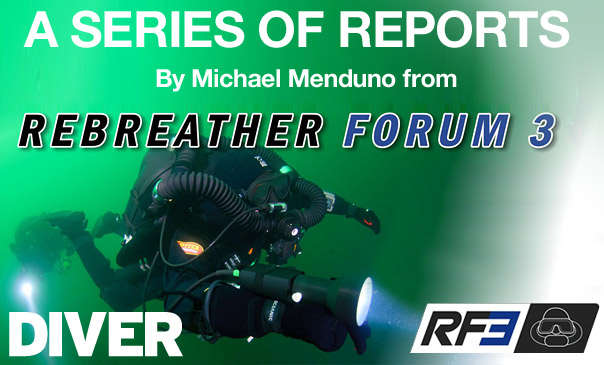PCO2: The Dark Matter of Rebreather Diving
Fifth in series of reports on Rebreather Forum 3 by Michael Menduno.
Similar to 02 sensing problems discussed in a previous RF3 report posted here, divers must contend with issues concerning PCO2, which has been dubbed the “dark matter of rebreather diving.” High PCO2s (0.03 bar and above) can cause hyperventilation, confusion, mental impairment, unconsciousness and death, may lower CNS O2 toxicity thresholds and is believed to be a factor in unexplained rebreather fatalities, hence the moniker “dark matter.” Worse, the diver may not be aware of the problem before a full onset of symptoms occurs.
According to Dr. John Clarke, Scientific Director of the Navy Experimental Diving Unit (NEDU), the Navy has been searching for solutions to the problem of CO2 sensing for more than 25 years. He told RF3 attendees that the need for CO2 sensing was also identified in the findings of Rebreather Forum 2.0. Divers have two information needs: first to monitor the duration of the scrubber canister, which varies with workload, depth, and temperature. Second, to detect a CO2 breakthrough as a result of a spent canister, mechanical failure or channeling.
Kevin Gurr, who is regarded as one of the gurus on CO2 sensing, began his session by sharing data from a recent Internet survey of 323 rebreather divers representing 25 different models of rebreathers. The results were surprising. Twenty-three percent of the divers did not know the maximum operating depth of their unit, and another 19 percent did not know the manufacturer’s stated scrubber duration. Forty-two percent of divers said that they experienced symptoms of hypercapnia for a total of some 297 incidents (some divers had more than one incident), however 64 percent said that they didn’t bailout, 19 percent said they bailed out sometimes. The results suggest better training and a cultural shift are needed!
Gurr next recounted the current methods used to monitor scrubber duration:
1) a duration timer based on manufacturer’s test data (usually conducted at two depths at 40°F (4°C) at a specified CO2 production rate)
2) a timer system based on diver oxygen consumption (divers produce about 0.8 liters of CO2 for every liter of O2 consumed) that takes account of workload but not depth or temperature
3) thermal sensing, also referred to as the “Temp Stik,” which measures how the scrubber’s thermal reaction front moves through the canister. Gurr explained that the Stik, which is used in the Ambient Pressure, VR technology and rEVO rebreathers, is a reasonable predictor of duration, but is slow to react to fast changing variables like work rate.
None of these methods are able to detect CO2 breakthrough.
Following Gurr, Dr. Dan Warkander, from the Navy Experimental Diving Unit (NEDU), who holds a patent on thermal sensing, compared “the situation” to the days of early scuba, when divers didn’t have a pressure gauge, instead diving with a J-valve on the tank. “Wouldn’t it be nice to have a gauge for your scrubber to tell you how much time you had left,” he offered.
Warkander went on to explain how factors such as workload, depth and temperature effect scrubber duration and how difficult it is to predict. For example, hard work can reduce duration by 50 percent, while light work can double duration. He said that scrubber duration can vary by a factor of five to 20 times through the combined effects of workload, temperature and depth. What’s worse, when a scrubber is spent, the threshold between no CO2 and too much, can happen in a matter of minutes.
As far as detecting scrubber breakthrough, or a seal failure, the VR Technology Sentinel is currently the only production unit with a gaseous infrared CO2 sensor (The Sentinel uses all four methods mentioned above in its CO2 monitoring package). Gurr said that, “we are 80 percent there in having a system that accounts for all components in a CO2 absorption system properly.” The last piece is a mouthpiece sensor that can measure end-tidal CO2, which is regarded as the “Holy Grail” of CO2 monitoring. Gurr estimated it’s still at least three plus years away.
The Forum acknowledged there is a poor understanding of operational limits with regards to depth and scrubber duration among trained rebreather divers, and recommended that training agencies do more to emphasize these issues and that manufacturers make data more readily available.
 Writer and technologist Michael Menduno published and edited aquaCorps: The Journal for Technical Diving (1990-1996), which helped usher tech diving into the mainstream of sports diving, and coined the term “technical diving.” He also organized the first Tek, EuroTek and AsiaTek conferences, and Rebreather Forums 1.0 and 2.0. Menduno, who is based in Berkeley, CA remains an avid diver.
Writer and technologist Michael Menduno published and edited aquaCorps: The Journal for Technical Diving (1990-1996), which helped usher tech diving into the mainstream of sports diving, and coined the term “technical diving.” He also organized the first Tek, EuroTek and AsiaTek conferences, and Rebreather Forums 1.0 and 2.0. Menduno, who is based in Berkeley, CA remains an avid diver.
More from the forum:
Part 1
Part 2
Part 3
Part 4
Part 6
Leave a Comment








